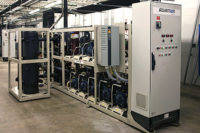Efforts by European and United Kingdom manufacturers of refrigeration equipment using low-global warming potential (GWP) refrigerants to get their products into the North America market have marked another milestone. Star Refrigeration Group of the United Kingdom has launched a U.S. subsidiary.
Azane Inc. is based in San Francisco and will act as the regional headquarters to serve the North American industrial refrigeration market with its “low-charge ammonia” Azane technology.
According to a statement, the industrial refrigeration group, whose Azanechiller and Azanefreezer technology has been installed worldwide, developed the technology to meet what it said were the “environmental and legislative challenges that the cooling industry was facing as Europe started the phaseout of ozone depleting refrigerant HCFC-22.”
The technology is being introduced to the United States market just as the U.S. refrigeration industry begins to see the effects of the EPA’s R-22 phaseout program.
The EPA did announce in October 2014 that supplies of new and imported R-22 would drop from 51 million pounds in 2014 to 22 million pounds in 2015 and continue a yearly downward trend to no new or imported R-22 allowed as of 2020.
Azane said this timeline means “the cost of R-22 will continue to rise and existing R-22 refrigeration systems will become uneconomical long before the substance is banned completely.”
Options
“The Azanechiller and Azanefreezer are factory-built industrial refrigeration packages which are both highly efficient and environmentally conscious,” the company said, noting “the design uses patented technology to deliver the lowest cost of ownership by minimizing running costs over 25 or more years.”
All Azane packages use ammonia and have been designed to operate with about one-tenth of the charge of a traditional refrigeration system, therefore avoiding many of OSHA’s Process Safety Management (PSM) and the EPA’s Remedial Product Management (RPM) regulations. Both PSM and RPM are based on toxicity issues with ammonia. Reducing the amount of ammonia on-site reduces the amount of regulatory requirements such as the number of relief valves.
Ammonia as a zero ODP and zero GWP refrigerant is not under threat of being banned.
Derek Hamilton, U.S. business development manager at Azane, said, “The good news is that there are plenty of options available to allow a smooth transition away from R-22. Low charge ammonia is one of a number of options available and we are always happy to talk to our customers and guide them through the various options.”
Stateside Manufacturing
With manufacturing facilities in Pennsylvania, the ammonia chiller and freezer are fabricated following U.S. standards and regulations and supplied nationwide. Azane Inc. also provides technical support, site surveys, proposals, and training to HVACR contractors, consultants, and operators and end-users, Hamilton said.
The Azane products consist of air-cooled chilling and freezing solutions for HVAC, food processing and freezing, process cooling, public refrigerated warehouses, ice rinks, and more.
The factory-built design of the Azane packages makes them suitable for new installations and upgrade projects, the company said. It added that the packages require no machinery room and can be located close to the cooling demand, making the installation simple and low cost.
Hamilton said, “In the USA, the use of ammonia has historically been restricted to large, distributed refrigeration systems. These systems are typically site-installed and require a central machinery room to house the refrigeration equipment. These systems also tend to use ‘pumped circulation’ technology which requires a relatively large quantity of ammonia.
“The advent of ‘low charge ammonia’ means that ammonia is now being considered in applications which were typically the domain of ‘commercial’ systems. These commercial systems often use the HFC refrigerants.
“Some users of HFC systems may be reluctant to switch to an ammonia system because of safety concerns. However the reality is that ammonia systems in general are very safe and the low-charge, packaged approach alleviates these concerns further by using the minimum amount of ammonia and ensuring that it stays within the refrigeration system.”
For further information, go to www.azane-inc.com.





